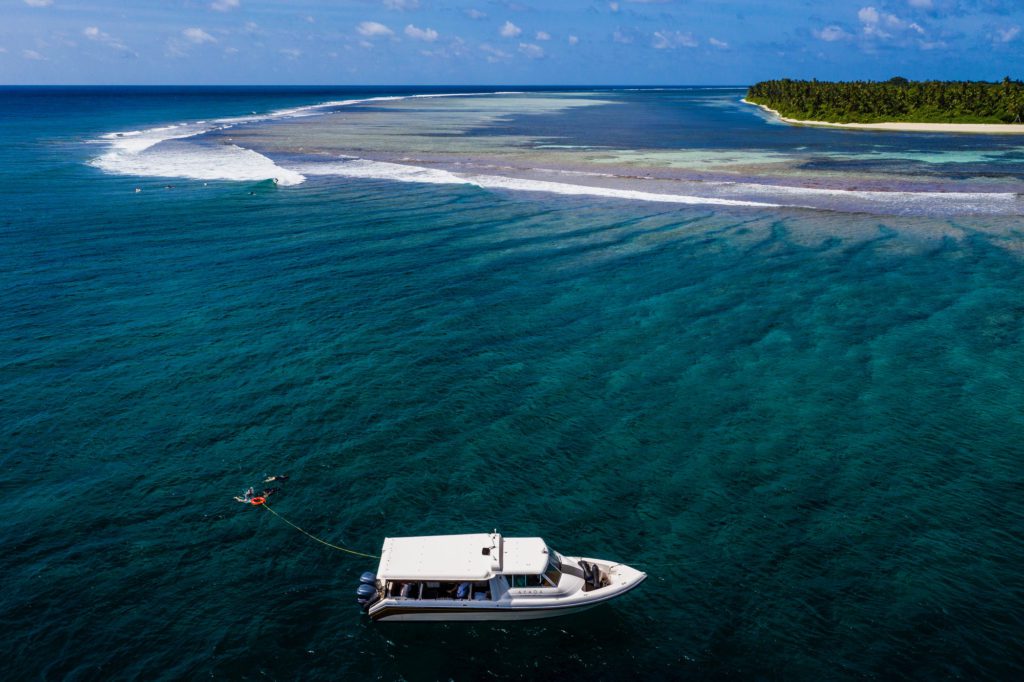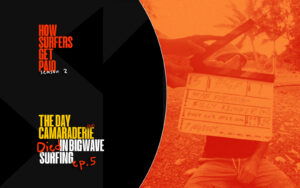You Deserve To Indulge In Perfect Waves, Warm Water And Luxurious Living, Don’t You?
Stab’s guide to surfing the Maldives.
Close your eyes and picture this: Glass-perfect almond barrels peeling along reefs so picturesque they bring a tear to Jacque Cousteau’s sun-reddened eye. Ruler groomed Indian Ocean swells detonating on coral so user-friendly that it may as well be upholstered in velvet. Sand whiter than your friend’s bleached teeth, teeming with similarly albino hermit crabs, fringe verdant jungles of pandanus and palm, hiding luxurious resorts.
Of course, if you did close your eyes you wouldn’t have gotten this far, but trust us — the Maldives are this nice and then some.
Somewhere between the Mentawais and Madagascar, you’ll find an idyllic smear of Indian Ocean atolls called the Maldives. A collection of 1,200 or so islands, coral keys, and sandbanks, plus the all-important slightly submerged coral reefs that surround them. The Maldives is the world’s lowest-lying nation and understands — unlike some — the value of the traveling surfer.
So it’s convenient that the Maldives’ privileged position in the middle of the Indian Ocean, copping many of the same swells as Indo, West Oz, and J-Bay means that anyone can find something to wet their beak any time of year. The place is beautiful, yeah, but it also pumps.

But if we’re being real with you — and when aren’t we — the Maldives aren’t Mavericks, Maui, Macaronis, or even Merewether. The waves in the Maldives may not pack the same punch found amongst their Indian Ocean neighbors in The Mentawais — but what they lack in thick-lipped cheesegrater-reef collisions they make up for in luxury resort comfort, apres-surf dining, flat-day fun, and a relative lack of desperate, tube-hungry, once-in-a-lifetime surf tourists.
More than just the perfect surf destination when you want to relax and get shacked, the Maldives is the perfect destination for visiting with a non-surfing spouse, significant other, or extended family. The islands are easily accessed from anywhere in the world, the resort facilities are the world leader in tropical coral key luxe, and the local approach to hospitality is the global gold standard.
So if you’ve had your fill of savage forays into the Malaria lands, or just simply want to go on a surf trip that won’t cost you a month in the doghouse, then grab your linen, an all-rounder quiver, the warmest water wax you can find, and let’s dive into the Maldives.
Full disclosure: I wrote this guide while absconded in one of the most expensive and luxurious resorts in the Maldives (with a nice little right wedge just off the infinity pool of our villa). If my appraisal of these islands seems overly gushing, just know that I’m writing this while being fed and pampered to an extravagant extent.

A Mid-Indian Ocean Miracle
Geography nerd warning, but I solidly frothed on this information. The Maldives are an archipelago of some 1200 islands, 90 of which are purely dedicated to resort living, another 1000 inhabited, and the rest in various stages of being a sandbank/deserted isle. The islands have risen up as coral cays off the Chago-Lakshawdepp undersea mountain range, which begins eastward of northern Madagascar and Mauritius/Reunion Island, runs north through the Indian Ocean, past the West Coast of Sri Lanka, and finishes somewhere in the Arabian Sea off the coast of Southern India.
The atolls and islands were formed after an ancient band of volcanoes stretching from Madagascar to India — which was formed after India moved through the Indian Ocean and smashed into Asia, creating the Himalayas! — decayed over millions of years into the sea, leaving behind the coral rings that had formed around their perimeters. That’s how, in the middle of an ocean that has an average depth of more than 3,700 meters, a chain of low-lying island paradises can come to exist.
The Maldives takes pride of place in the middle of the ridge and seeing as though the archipelago stretches for 871 kilometers, we can broadly break them up into three sections — southern, central, and northern atolls. For reference, the capital Male, where you will fly in to, is in the southern end of the Northern Atolls.
Mercifully for those of us on tight schedules/budgets, we can find a plethora of decent waves in the islands around Male, with some of the Maldives’ best waves — Sultans, Honkys, Lohis, Jailbreaks, and others — located a relatively short speedboat ride from the airport.
In the Northern Atolls you will find more of the Maldives’ trademark luxury resorts, but less surf – with much of the swell blocked by the Male atolls. Nevertheless, during the Indian Ocean swell season there will be plenty to pick off here, and much of it if not undiscovered, un-not-so-often-spoken-about.
The Southern Atolls are far from Male both in distance, as well as culture and language. This is an area where you can find more exciting waves and fewer best friends in the lineup than the atolls closer to Male.
Between Male and the southern Atolls, the Central part of the Maldives presents plenty of great waves, less crowded, with the long rights at Ying Yangs taking the jewel in the crown position.
In short, there’s a whole lot going on out there and plenty to still be discovered.

Who’s It For?
The Maldives are for everybody and anybody who wants to score perfect waves without the threat of scalping themselves under guillotining lips. Yeah, they break over coral, but it’s just a little… thinner there. More perfect. Less intimidating. Maybe less rewarding. Probably more fun.
How To Get There?
Not the easiest travel route from the USA — as it is almost on the other side of the world — but you will most likely fly through the UAE. From Europe, it’s pretty handy, with a six-hour flight or so to your transit in Dubai or Qatar or Abu Dhabi, followed by an easy four hours to Male. From Australia and New Zealand bounce through Singapore or, again, the UAE. All flights will take you to Male and then you’ll boogie out to your destination from there, either by domestic flight, seaplane, ferry, or speed boat if you’re hitting the Male atolls.

What To Expect
Fun. Playful. Postcard perfection. Wonderful. But not often gnarly. This makes the Maldives a perfect surf destination for intermediate surfers, as well as core dawgs looking for something a little more relaxing.
But whatever your thalassophilic aspirations, on land the Maldives are all about that resort life. Overwater villas with thrice daily housekeeping; Michelin starred chefs on beachcombing sojourns; white sand beaches haloed by vibrant coral reefs, fringed with over-productive coconut palms. Fresh fish from the sea served up by ever-smiling butlers. Expensive cocktails greedily gobbled down after a big day of easing into three-foot thin-lipped peelers.
And when there aren’t waves you can do just about everything you’d expect from tropical island resort paradises. The snorkeling and scuba diving are second to none, and just off the end of my villa I swam with reef sharks, sea turtles, eagle and manta rays, and an aquarium of multicolored fish picking and pecking at the coral and defecating what will one day be sand.

Then there’s the possibility to SUP, kitesurf, windsurf, e-foil, and a whole bunch of surf-adjacent overwater activities that you wouldn’t be caught dead doing at home, but that somehow make sense in the Maldives.
As far as what to look for in terms of accommodation, know your budget and understand that unlike many resorts in the Caribbean and elsewhere, all-inclusive isn’t really a thing in the Maldives. So make sure you factor in your food and beverage and activities appetite when you’re deciding on your resort.
For surfing, some of the Maldives best breaks are accessed directly and exclusively from resorts — like the left at Lohis which you can dive into from the bar-restaurant of the Hudhuranfushi resort neal Male. Then you’ve got ultimate luxury like Soneva Fushi (where I stayed), where for a fee (that, if you’re staying there, you can easily afford) speedboats will whizz you to whichever break appeals at that time of day/year (that’s when the wedge off the last overwater villa isn’t breaking).
What To Eat
While in the resorts you will subsist on a diet of just about anything, what really gets the guts growling are the products that are bountiful in the archipelago. Coconuts, curry, fruits, and fresh fish really shine out here, especially when they all come together. I ate some of the best and freshest sashimi that my philistine pallet has ever danced with, the spicy Maldivian chilis in their curries can really clear the saltwater from your sinuses, and breakfast punctuated with rambutan and mangosteen and papaya and fruit juices and so on will probably make you live for six years longer than you were due to.
In addition to the local cuisine, Sri Lankan and Indian specialties delight, as do southeast Asian curries and stir fries. Western food is everywhere, too, but don’t expect too much meat, as pork is restricted in the Muslim diet, and given that the islands are all so small, cattle raising isn’t really affordable.
And for the boozehounds amongst us, while all alcohol is banned for Maldivians, the resorts have been given the green light to serve overpriced plonk, cocktails, and cold beers. Just don’t treat this like one of those sometimes-surf-always-rage trips like many of us do in Bali. This isn’t a party destination, but somewhere where we can act like civilized folk and not the bleary-eyed tube monsters. Think well-deserved cocktails and ice-cold beers post-surf, sommelier-selected wines at dinner, maybe even mimosas at breakfast if the surf’s looking flat, instead of guzzling flavored ethanol by the bucketload. You can do this.

When To Pull The Trigger
You could have a swing year-round, but your best bet is the Indian Ocean swell window of May to late September, when the Roaring 40s pushes Antarctic nightmares past the Cape of Good Hope, that go on to bend back towards J-Bay’s long walls, before lining up and period-lengthening and smashing into Indonesia’s southern shores and Northwest Australia’s mysto urchin coast. Some of that much-coveted swell will head eastward and swing back into Sri Lanka and — mercifully — the Maldives.
And this is when we will strike, making the Maldives a great surf option for Saffas and Aussies escaping mild winters, or North Americans and Europeans making the dash from the summer doldrums. During this window, you’ll find consistent surf across the atolls, especially those facing southeast — from the near-Male hotspots and south.
Out of season, you’ll be looking at more localized swell events, with many running up the inside of the archipelago into the southwestern facing reef passes. This is a good time to convince your more landlocked loved ones to take a trip if you’re coming from the Northern Hemisphere, however. A winter-timed escape from the upper latitudes to a tropical paradise will be very appreciated by those who you hold dearly, but who may not display the same affection to your main squeeze — prancing around on waves.
And is there a better way to endear your passion for surfing to your loved ones than propping them up with a cocktail and a massage while you go and scour the atolls for fun waves? If there is, we’re yet to see it.

Final Word
While lacking some of the punch of other surf destinations, the Maldives more than makes up for it with amenities, approach to tourism, diversity of setups, and scarcity of other surfers as soon as you get a little off the beaten track. Plus, while not death-defying, the waves are perfect, fun, varied, and rippable, with every day offering up ideal conditions for somewhere within striking distance. And we can’t emphasize enough that this is the kind of place to bring a non-surfing significant other, because you’ll be sure to keep them occupied while you’re busy burying yourself in not back-breaking, but still beautiful barrels.
Relax, score waves in your boardshorts, taste luxury, and keep your main squeeze happy? That’s a win-win in anybody’s books. Go get it.













